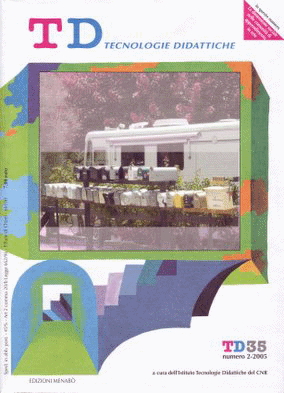La dimensione sociale del modello delle Communities of Inquiry
Contenuto principale dell'articolo
Abstract
Dettagli dell'articolo
Gli autori che pubblicano su questa rivista accettano le seguenti condizioni:
- Gli autori mantengono i diritti sulla loro opera e cedono alla rivista il diritto di prima pubblicazione dell'opera, contemporaneamente licenziata sotto una Licenza Creative Commons CC BY 4.0 Attribution 4.0 International License.
- Gli autori possono aderire ad altri accordi di licenza non esclusiva per la distribuzione della versione dell'opera pubblicata (es. depositarla in un archivio istituzionale o pubblicarla in una monografia), a patto di indicare che la prima pubblicazione è avvenuta su questa rivista.
- Gli autori possono diffondere la loro opera online (es. in repository istituzionali o nel loro sito web) prima e durante il processo di submission, poiché può portare a scambi produttivi e aumentare le citazioni dell'opera pubblicata (Vedi The effect of Open Access).
Riferimenti bibliografici
Anderson T., Rourke L., Garrison D. R., Archer W. (2001), Assessing teaching presence in a computer conferencing context, Journal of Asynchronous Learning Networks , vol. 5, n. 2
Austin J. L. (1962), How to do things with words, Harvard University Press, Cambridge, MA (tr. it., Come fare cose con le parole, Marietti, Genova, 1987)
Bruner J. S. (1997), La cultura dell’educazione, Feltrinelli, Milano
Capozzoli M., McSweeney L., Sinha D. (1999), Beyond kappa: A review of interrater agreement measures, The Canadian Journal of Statistics, vol. 27, n. 1, pp. 3-23
De Bruyn L. (2004), Monitoring online communication: can the development of convergence and social presence indicate an interactive learning environment?, Distance Education, vol. 25, n. 1, pp. 67-81
Garrison D. R., Anderson T. (2003), E-Learning in the 21st century, Routledge Falmer, London, UK
Garrison D. R., Anderson T., Archer W. (1999), Critical inquiry in a text-based environment: computer conferencing in higher education, The Internet and Higher Education, vol. 2, n. 2-3, pp. 87-105
Garrison D. R., Anderson T., Archer W. (2001), Critical thinking, cognitive presence, and computer conferencing in distance education, American Journal of Distance Education, vol. 15, n. 1, pp. 7-23
Herring S. C. (2004), Computermediated discourse analysis. An approach to researching online behavior, in S. A. Barab, R. Kling, J. H. Gray (eds.), Designing for virtual communities in the service of learning, Cambridge University Press, Cambridge, UK, pp. 338-376
Hillman D. C., Willis D. J., Gunawardena C. N. (1994), Learner-interface interaction in distance education: An extension of contemporary models and strategies for practitioners, The American Journal of Distance Education, vol. 8, n. 2, pp. 30-42
Krippendorff K. (2003), Content analysis: an introduction to its methodology, Sage Publications, Thousand Oaks, CA
Krippendorff K. (2004), Reliability in content analysis. Some common misconceptions and recommendations, Human Communication Research, vol. 30, n. 3, pp. 411-433
Meyer K. (2004), Evaluating online discussions: Four difference frames of analysis, Journal of Asynchronous Learning Networks, vol. 8, n. 2, pp. 101-114
Moore M. (1989), Editorial: Three types of interaction, The American Journal of Distance Education, vol. 3, n. 2, pp.1-7
Rourke L., Anderson T. Garrison D. R., Archer W. (1999), Assessing social presence in asynchronous, text-based computer conferencing, Journal of Distance Education, vol. 14, n. 2, pp. 51-70
Rourke L., Anderson T., Garrison D. R., Archer W. (2001), Methodological issues in the content analysis of computer conference transcripts, International Journal of Artificial Intelligence in Education, n. 12, pp. 8-22
Tajfel H., Turner J. C. (1986), The social identity theory of intergroup behaviour, in S. Worchell, W. G. Austin (eds.), Psychology of intergroup relations, Nelson- Hall, Chicago, pp. 7-24
Wang M. (2004), Correlational analysis of student visibility and performance in online learning, Journal of Asynchronous Learning Networks, vol. 8, n. 4
Wenger E. (1998), Communities of practice. Learning, meaning, and identity, Cambridge University Press, Cambridge, UK

